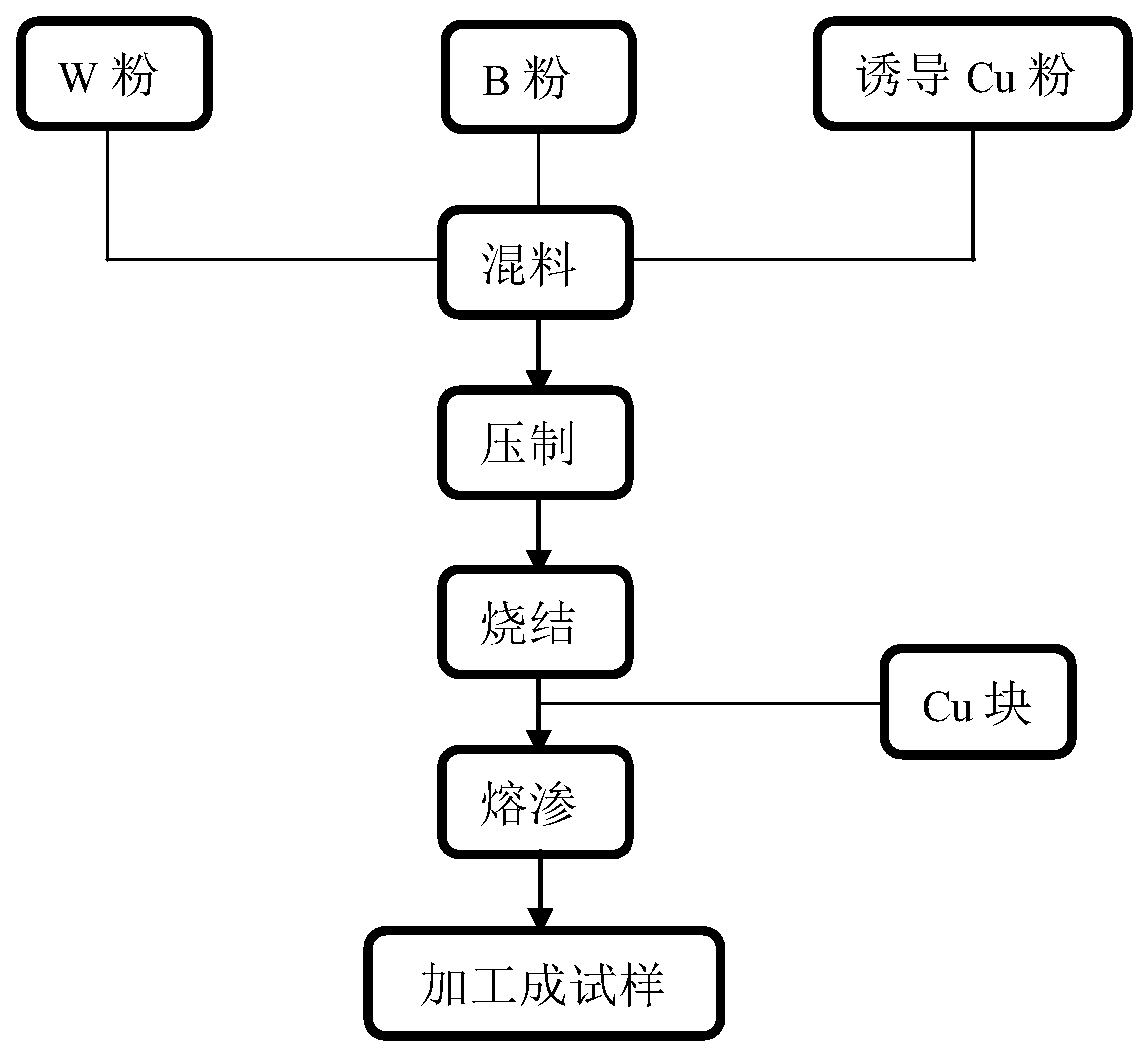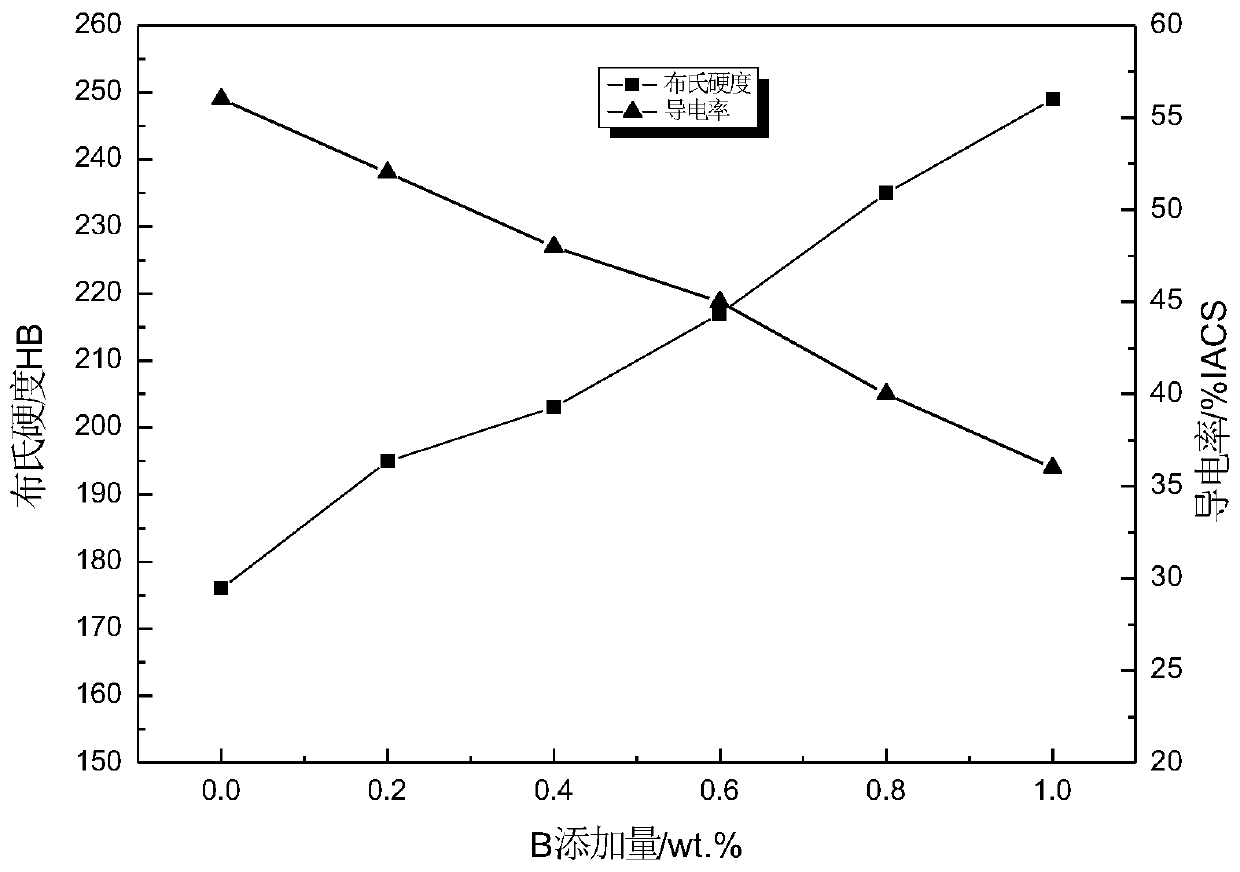Method for in-situ self-reproducing tungsten boride reinforced CuW alloy
A self-generated tungsten boride and alloy technology, applied in the field of electrical materials, can solve the problems of particle surface pollution, avoid surface pollution, save time and cost, and reduce the process of adding and mixing
- Summary
- Abstract
- Description
- Claims
- Application Information
AI Technical Summary
Problems solved by technology
Method used
Image
Examples
Embodiment 1
[0039] Weigh W powder and B powder (with an average particle size of 0.2 μm) with an average particle size of 1 μm. The amount of B powder added is 0.2% of the W powder quality, and the induced copper powder (average particle diameter at 5 μm) of W powder quality 5% is mixed on the V-shaped mixer of 80r / min for 4 hours, and used after mixing. Press and form with a hydraulic press to obtain a W compact. The pressing pressure is 350MPa, and the holding time is 50s. Put the W compact into a graphite crucible, then put the crucible into an atmosphere sintering furnace, and after passing in hydrogen gas for 40 minutes, check the purity of the hydrogen gas, ignite the hydrogen gas after confirming safety, turn on the cooling water, and start heating at a rate of 8°C / min. The heating rate is to raise the temperature. When the sintering temperature is 600°C, keep the temperature for 1.5h and then raise the temperature to 1000°C at a speed of 10°C / min, and the holding time is 1h. Nat...
Embodiment 2
[0041] Weigh W powder and B powder (with an average particle size of 25 μm) with an average particle size of 15 μm. The amount of B powder added is 0.4% of the W powder quality, and the induced copper powder (average particle diameter at 60 μm) of W powder quality 8%, is mixed on the V-shaped mixer of 50r / min for 8 hours, and used after mixing. Press and form with a hydraulic press to obtain a W compact. The pressing pressure is 400MPa, and the holding time is 50s. Put the W compact into a graphite crucible, then put the crucible into an atmosphere sintering furnace, and after passing in hydrogen gas for 40 minutes, check the purity of the hydrogen gas, ignite the hydrogen gas after confirming safety, turn on the cooling water, and start heating at a rate of 20°C / min. The heating rate is to raise the temperature. When the sintering temperature is 800°C, keep it for 1 hour and then raise the temperature to 950°C at a speed of 15°C / min. Then stack the cleaned pure copper block...
Embodiment 3
[0043]Weigh W powder with an average particle size of 15 μm and B powder (with an average particle size of 30 μm). The amount of B powder added is 0.6% of the W powder quality, and the induced copper powder (average particle size at 30 μm) of the W powder quality 7%, is mixed for 6 hours on the V-type mixer of 60r / min, and used after mixing. Press and form with a hydraulic press to obtain a W compact. The pressing pressure is 150MPa, and the holding time is 90s. Put the W compact in the graphite crucible, then put the crucible into the atmosphere sintering furnace, pass in the hydrogen gas for 40 minutes, check the purity of the hydrogen gas, ignite the hydrogen gas after confirming the safety, turn on the cooling water, and start heating at a rate of 10°C / min. The heating rate is raised. When the sintering temperature is 1000°C, after holding for 1.5h, the temperature is raised to 1200°C at a speed of 20°C / min, and the holding time is 1h. It is naturally cooled to room tempe...
PUM
 Login to View More
Login to View More Abstract
Description
Claims
Application Information
 Login to View More
Login to View More - R&D
- Intellectual Property
- Life Sciences
- Materials
- Tech Scout
- Unparalleled Data Quality
- Higher Quality Content
- 60% Fewer Hallucinations
Browse by: Latest US Patents, China's latest patents, Technical Efficacy Thesaurus, Application Domain, Technology Topic, Popular Technical Reports.
© 2025 PatSnap. All rights reserved.Legal|Privacy policy|Modern Slavery Act Transparency Statement|Sitemap|About US| Contact US: help@patsnap.com



